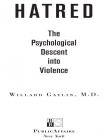Hatred, Willard Gaylin [best ebook for manga txt] 📗

- Author: Willard Gaylin
Book online «Hatred, Willard Gaylin [best ebook for manga txt] 📗». Author Willard Gaylin
The psychotic individual may interpret events in life in a totally idiosyncratic manner—driven by his inner need to see things in a particular way—but he still will take his stimulus from the world around him. Except for the deteriorated schizophrenics of the back mental wards, most schizophrenics are not totally out of touch with reality. They are thus susceptible to the same influences as the rest of us. John Nash did work for the CIA, but in a mundane manner. Still he built his fantasies around his mathematical abilities and a romanticized need to be involved in the battle against evil represented by the Soviet Union during the Cold War.
Kaczynski was most likely aware of the battles over the possibility of human cloning, and for that reason for him genetics became the area of research in which the debate over the limits of scientific intervention in the human condition would be centered. He was, in addition, obsessed with computers. Methods of communicating have always been great source material for the delusional, particularly those that use invisible sources of energy with capacity to penetrate and influence—like radiation. Kaczynski, in his focus on computers, was in direct line with dozens of patients I saw in my early training who believed that “radio waves,” “X rays,” “television waves beamed from outer space” were means of either sending messages to them or taking control of them.
The real world may not appear the same to psychotics as it does to us, but the real world does influence them. Since anything can play into a preformed delusional system, schizophrenics can be the instruments, unintended or otherwise, of passionate and often overwrought single-cause advocates who see the whole world as secondary to their mission. In protecting the innocent unborn, passionate right-to-lifers have been prepared to take the life of the innocent mother. Animal rightists often seem willing to sacrifice researchers for rats, certainly for dogs or monkeys. But even if the more responsible members of those causes would not engage in such violence, their rhetoric suggests that they would, or it implies that to do so would be just and honorable. This rhetoric is ready tinder, waiting to ignite the psychotic, who is looking for legitimate explanations for his inner agonies and is eager to do battle against the evil that torments him. The inflated rhetoric of the radical fringe groups in the various rights movements supplies the rationalization that the psychotic needs and locates an enemy for him. He can now project his internal conflict to those who have been identified by others as threatening innocent populations or the world itself.
In May 2002, after the FBI had issued an all-points bulletin in relation to a serial bomber, Lucas John Helder, a twenty-one-year-old college student, was arrested. Cameron Helder, the defendant’s father, said to reporters: “I really want you to know that Luke is not a dangerous person. I think he’s just trying to make a statement about the way our government is run.”43
By definition anyone who plants eighteen pipe bombs, injuring six people, is a dangerous person. If I were to ask the senior Helder, who knew of his son’s actions when he issued his statement, whether he thought delivering pipe bombs into the mailboxes of innocent Americans was a dangerous action, I am reasonably sure that he would have answered yes. The father was in the same state of denial one encounters with other parents of dangerous children. And he was not alone. Even after all the evidence was assembled and published, Helder’s friend said: “There’s no way he could be armed and dangerous. That’s just not him.” His roommate and another acquaintance, a fellow member of the golf team, offered in Helder’s defense the fact that “he never showed any emotion” even when he hit a bad golf shot, an observation that would be a red flag to any psychiatrist.
In support of a denial mechanism designed to protect us from painful realities, Cameron Helder did that which many liberal-minded individuals are wont to do: He attempted to separate the individual from his actions. He knew that the inner Lucas John Helder, his son, was a loving and decent boy. But there is no inner self that is separated from one’s actions. Like it or not, what one does, one’s behavior, is a better definition of the self than one’s inner feelings. To probe for unconscious determinants of behavior and then define the person in those terms exclusively, ignoring his overt behavior, is a greater distortion than ignoring the unconscious completely. You, the essential you, will be better represented and understood through what you do than what you think.
But did the father even know what the son was thinking? In an attempt to explain his behavior, Lucas John Helder sent the Badger Herald, the University of Wisconsin’s newspaper, a six-page letter, filled with chaotic statements about government, technology, and the environment. It included the following: “Do you wonder why you are here? Do you wonder what is out there . . . way out there? I remember those times of uncertainty, and I can’t tell you how great it is to know, to know eternally, and to be.”44
Much of his rhetoric and behavior suggests the psychotic: the sudden departure from his typical behavior; the discontinuity of actions from the stimuli that preceded them; the solitary nature of his behavior; his grandiosity and his exultation at the “great feeling” of liberation. All of this is more reminiscent of Schreber than of the organized hate groups that lynched blacks in the South, or the mobs of toughs that periodically go gay bashing, or the psychopathic teenagers that set





Comments (0)